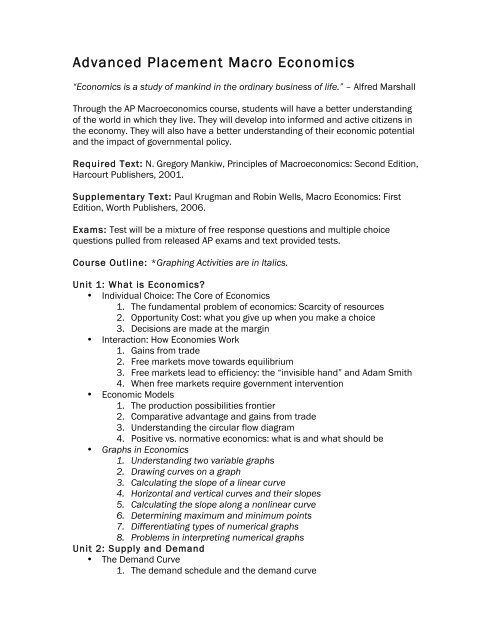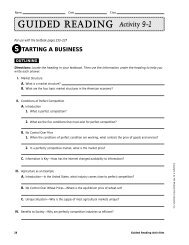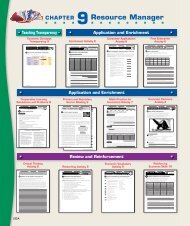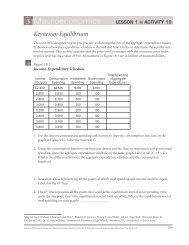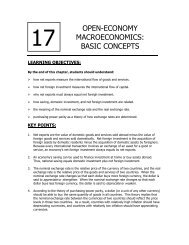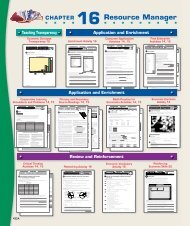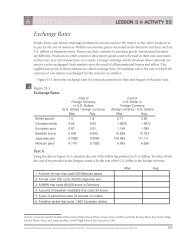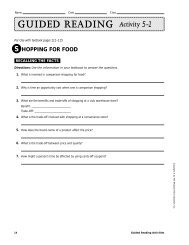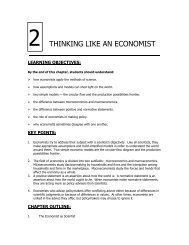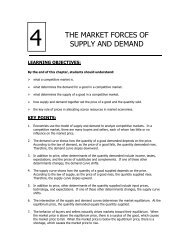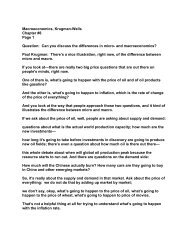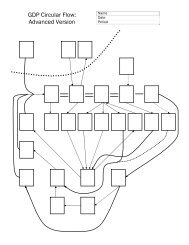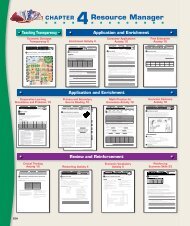AP Macroeconomics Syllabus
AP Macroeconomics Syllabus
AP Macroeconomics Syllabus
Create successful ePaper yourself
Turn your PDF publications into a flip-book with our unique Google optimized e-Paper software.
Advanced Placement Macro Economics<br />
“Economics is a study of mankind in the ordinary business of life.” – Alfred Marshall<br />
Through the <strong>AP</strong> <strong>Macroeconomics</strong> course, students will have a better understanding<br />
of the world in which they live. They will develop into informed and active citizens in<br />
the economy. They will also have a better understanding of their economic potential<br />
and the impact of governmental policy.<br />
Required Text: N. Gregory Mankiw, Principles of <strong>Macroeconomics</strong>: Second Edition,<br />
Harcourt Publishers, 2001.<br />
Supplementary Text: Paul Krugman and Robin Wells, Macro Economics: First<br />
Edition, Worth Publishers, 2006.<br />
Exams: Test will be a mixture of free response questions and multiple choice<br />
questions pulled from released <strong>AP</strong> exams and text provided tests.<br />
Course Outline: *Graphing Activities are in Italics.<br />
Unit 1: What is Economics?<br />
• Individual Choice: The Core of Economics<br />
1. The fundamental problem of economics: Scarcity of resources<br />
2. Opportunity Cost: what you give up when you make a choice<br />
3. Decisions are made at the margin<br />
• Interaction: How Economies Work<br />
1. Gains from trade<br />
2. Free markets move towards equilibrium<br />
3. Free markets lead to efficiency: the “invisible hand” and Adam Smith<br />
4. When free markets require government intervention<br />
• Economic Models<br />
1. The production possibilities frontier<br />
2. Comparative advantage and gains from trade<br />
3. Understanding the circular flow diagram<br />
4. Positive vs. normative economics: what is and what should be<br />
• Graphs in Economics<br />
1. Understanding two variable graphs<br />
2. Drawing curves on a graph<br />
3. Calculating the slope of a linear curve<br />
4. Horizontal and vertical curves and their slopes<br />
5. Calculating the slope along a nonlinear curve<br />
6. Determining maximum and minimum points<br />
7. Differentiating types of numerical graphs<br />
8. Problems in interpreting numerical graphs<br />
Unit 2: Supply and Demand<br />
• The Demand Curve<br />
1. The demand schedule and the demand curve
2. Differentiating a change in quantity demanded from a change in<br />
demand<br />
3. Shifts of the demand curve<br />
4. Graphing the Demand Curve<br />
• The Supply Curve<br />
1. The supply schedule and the supply curve<br />
2. Differentiating a change in quantity supplied from a change in supply<br />
3. Shifts of the supply curve<br />
4. Graphing the Supply Curve<br />
• Equilibrium<br />
1. Finding the Equilibrium price and quantity: putting supply and demand<br />
together<br />
2. Response of market price to equilibrium<br />
3. Graphing Equilibrium<br />
• Changes in Supply and Demand<br />
1. When the demand curve shifts<br />
2. When the supply curve shifts<br />
3. Simultaneous shift in supply and demand<br />
4. Graphing Changes in Supply and Demand<br />
• Price Ceilings<br />
1. How price ceilings cause inefficiency<br />
2. Why price ceilings exist<br />
3. Graphing the effect of Price Ceilings<br />
• Price Floors<br />
1. How price floors cause inefficiency<br />
2. Why price floors exist<br />
3. Graphing the effect of Price Floors<br />
• Controlling Quantities<br />
1. Establishing quantity controls<br />
2. The cost of quantity controls<br />
3. Taxation as a quota<br />
4. Revenue from excise taxes<br />
5. The hidden costs of taxation<br />
6. Graphing the effect of controls on the market<br />
• Consumer Surplus and the Demand Curve<br />
1. Willingness to pay and the demand curve<br />
2. Willingness to pay and the consumer surplus<br />
• Producer Surplus and the Supply Curve<br />
1. Cost and producer surplus<br />
2. Changes in producer surplus<br />
• Surplus and the Gains from Trade<br />
1. The gains from trade<br />
2. The efficiency of markets<br />
3. Graphing Surpluses<br />
Unit 3: Introduction to <strong>Macroeconomics</strong><br />
• The Big Picture<br />
1. Micro vs. macro<br />
2. Macroeconomic policy
3. Long-run growth<br />
4. Economic aggregates: adding it all up<br />
• The Business Cycle<br />
1. Aggregate output<br />
2. Taming the business cycle<br />
3. Long-Run Economic Growth<br />
4. Inflation and deflation<br />
• Tracking the Macroeconomy<br />
1. GDP and its calculation<br />
2. Calculating real GDP and aggregate output<br />
3. Flaws in GDP: what it does not measure<br />
4. The unemployment rate<br />
5. Price Indexes and the aggregate price level<br />
6. The consumer price index<br />
Unit 4: The Economy in the Long Run<br />
• Long-Run Economic Growth<br />
1. Real GDP per capita<br />
2. Explaining growth through productivity<br />
3. The aggregate production function<br />
4. Saving and investment spending<br />
5. Foreign Investment, Education infrastructure, and research &<br />
development<br />
• Savings, Investment Spending, and the Financial System<br />
1. The market for loanable funds<br />
2. Government policy<br />
3. Three tasks of a financial system<br />
4. Types of assets: what con you do with your money?<br />
5. Financial Intermediaries: more than just banks<br />
6. The demand for stocks, stock prices and macroeconomics<br />
Unit 5: Short-Run Economic Fluctuations<br />
• Aggregate Supply<br />
1. The short-run aggregate supply curve<br />
2. The long-run aggregate supply curve<br />
3. Graphing Aggregate Supply<br />
• Aggregate Demand<br />
1. The downward slope of the aggregate demand curve: money supply<br />
2. Shifts in the aggregate demand curve: changing the money supply<br />
3. Short-run macroeconomic equilibrium<br />
4. shifts of the short-run aggregate supply curve: productivity<br />
5. Short-run effects of a shift in aggregate demand<br />
6. Long run macroeconomic equilibrium: maintaining steady growth<br />
7. Responding to supply shocks; role of the government<br />
8. Graphing Aggregate Demand<br />
• Income and Expenditure<br />
1. Disposable income and consumer spending<br />
2. Shifts in the aggregate consumption function<br />
3. The interest rate and investment spending
4. Expected future real GDP, production capacity, and investment<br />
spending<br />
5. Inventories and unplanned investment spending<br />
6. Planned aggregate spending and real GDP<br />
7. Income-expenditure equilibrium<br />
8. The multiplier process and inventory adjustment<br />
9. Deriving the multiplier Algebraically<br />
• Fiscal Policy<br />
1. Taxes, purchases of goods and services, government transfers, and<br />
borrowing<br />
2. The government budget and total spending<br />
3. Expansionary and contractionary fiscal policy<br />
4. Multiplier effects of an increase in government purchases of goods and<br />
services<br />
5. Multiplier effects of changes in government taxes and transfers<br />
6. Balanced budget as a measure of fiscal policy<br />
7. Deficits, surpluses, and debt<br />
8. Problems posed by rising government debt<br />
• Money, Banking, and the Federal Reserve System<br />
1. Money: what it is, its role, types of<br />
2. Measuring the money supply<br />
3. What banks do<br />
4. Bank regulation<br />
5. How banks create money through loaning<br />
6. Reserves, bank deposits, and the money multiplier<br />
7. The Fed: America’s central bank<br />
8. Reserve requirements and the discount rate<br />
9. Open market operations<br />
10. The Discount Rate<br />
• Monetary Policy<br />
1. The opportunity cost of holding money<br />
2. The money demand curve; shifts of and prices<br />
3. The equilibrium interest rate<br />
4. Monetary policy and the interest rate<br />
5. Expansionary and contractionary monetary policy<br />
6. Monetary policy and the multiplier<br />
7. Short-run and long-run effects of an increased in the money supply<br />
8. Monetary neutrality<br />
9. The interest rate in the long run<br />
Unit 6: The Supply Side and the Medium Run<br />
• Labor Markets, Unemployment, and Inflation<br />
1. Job creation and job destruction<br />
2. Frictional vs. structural unemployment<br />
3. The nominal rate of unemployment<br />
4. Okun’s Law<br />
5. Phillip’s curve: short-run, long-run, and inflation expectations<br />
• Inflation, Disinflation, and Deflation<br />
1. The inflation tax
2. Hyperinflation<br />
3. Effects of expected and unexpected inflation<br />
4. The costs of inflation<br />
5. The optimal rate of inflation<br />
6. Effects of expected and unexpected deflation<br />
Unit 7: Events and Ideas<br />
• Classical <strong>Macroeconomics</strong><br />
1. Money and the price level<br />
2. The business cycle<br />
3. Keynes’s theory<br />
4. Challenging Keynes; monetary policy<br />
5. Monetarism<br />
6. The political business cycle<br />
7. Rational Expectations<br />
• Modern Consensus<br />
1. The effects of various policies on fighting inflation, recessions, and<br />
unemployment in the long-run<br />
2. A discretionary use of fiscal and monetary policies<br />
Unit 8: The Open Economy<br />
• International Trade<br />
1. Comparative vs. absolute advantage<br />
2. Supply, Demand, and International Trade<br />
3. Trade Protection: tariffs and quotas<br />
• Open-Economic Policy<br />
1. Capital Flows and the Balance of Payments<br />
2. The Role of the Exchange Rate<br />
3. Exchange Rate Policy<br />
Unit 9: Personal Finance<br />
• NEFE: National Endowment for Financial Education<br />
1. Your Financial Plan: Where it all Begins<br />
2. Budgeting: Making the Most of Your Money<br />
3. Investing: Making Money Work for You<br />
4. Good Debt, Bad Debt: Using Credit Wisely<br />
5. Your Money: Keeping it Safe and Secure<br />
6. Insurance: Protecting What You Have<br />
7. Your Career: Doing What Matters Most<br />
• More Practical Economics<br />
1. Buying or Renting a Car<br />
2. Housing Rights and Responsibilities<br />
3. FAFSA: Free Application for Federal Student Aid<br />
4. Dangers of Credit Cards – Movie “Maxed Out”<br />
5. Navigating the Stock Market<br />
6. Understanding Income Tax<br />
7. Bankruptcy: Facts and Fiction<br />
8. Opening a Small Business<br />
9. Common Scams and Internet Dangers


